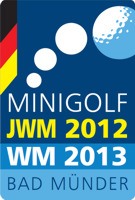
About Bad Münder
History, ecomony, directions
The town in the valley between Deister and Süntel was mentioned first in 840. The people have been utilizing the healing power of the saltwater, sulphur and bitter springs for a long time. During the so called "Hildesheim Stiftsfehde" (a conflict between Hildesheim and Braunschweig) from 1519-1523 and the thirty-year war from 1630-1648 the town was destroyed completely. Since 1872 Münder is reachable by train. In 1936 Münder received the legal status of a spa, so was renamed from Münder to Bad Münder. The local people live from the health system, tourism and the glass and furniture industry.
You reach Bad Münder by car via the roads (Bundesstraße) B442 and B217. The B217 from Hannover to Hameln passes Bad Münder on the South. Coming on the motorway A2 you leave at the exit Lauenau (exit nr. 37) and follow the B442 towards Bad Münder.
Culture and sights
- Söltjer well in the pedestrian precinc
- A saltworks ("Gradierwerk") at the health resort centre in the health resort park
- Hamel spring in Hamelspringe
- Nordmanns tower (379 m) und Anna tower (405 m) on the Deister hills
- Süntel tower (440 m)
- "Bergschmiede" (hill smithy) in the Süntel hills
- Jewish graveyard in Deisterallee: The graveyard comprises 28 gravestones from the years 1826 to 1917 of a larger stock with considerable signs of damage. The final funeral took place in 1937. On the 9th of November 1938 (the day of the pogroms against jews) the graveyard was demolished. It was recovered in 1961
- The "Steinhof"
What about this? Why not frighten the kids (just a bit)?
Are you afraid of ghosts? Have a look here: "Süntelgeister". There are guided tours through Bad Münder for groups of children.
Museums and buildings
- The museum in the "Wettbergscher Adelshof", Kellerstraße 13, shows diverse collections: Apart from geological and archaeological finds you can learn about the townscape of former epochs.
- The "Bürgerhaus", Kellerstraße 19, shows an "Ackerbürgerhaus", how it was furnished around the year 1880.
- The German Museum of Chairs ("Deutsche Stuhlmuseum") is located in the district Eimbeckhausen since 2003.
- The Lutheran-Protestant church Petri-Pauli in Bad Münder, which tower from 1528 still exists, was rebuilt from 1839-40.
- The "Wettberg-Burghof" in Bad Münder (designed in architecture style "Weserrenaissance") was built in the 17th century.
- The "Steinhof" in Bad Münder was built in the 13th century.
- The "Hasperde" castle (also designed in "Weserrainessance") is used as a residential home for the elderly today.
Health resort park, natural monuments
- There is a 140000 m² large health resort park in Bad Münder, designed by the Swiss landscape architect Dieter Kienast. You find numerous species of plants here, even some of the rare, indigenous "Süntelbuchen" (a special sort of a beech tree). There is a weather station of the German TV programme "ARD" in the western part of the park.
- There is a very old "Süntelbuche" in the Wermuthstraße, planted in 1850.
Public institutions
- Tourist-Information der GeTour GmbH
- Rohmelbad, an outdoor swimming pool with its own mineral water spring
- Kids and Youth Centre "Point" in Friedrich-Ludwig-Jahn-Straße




